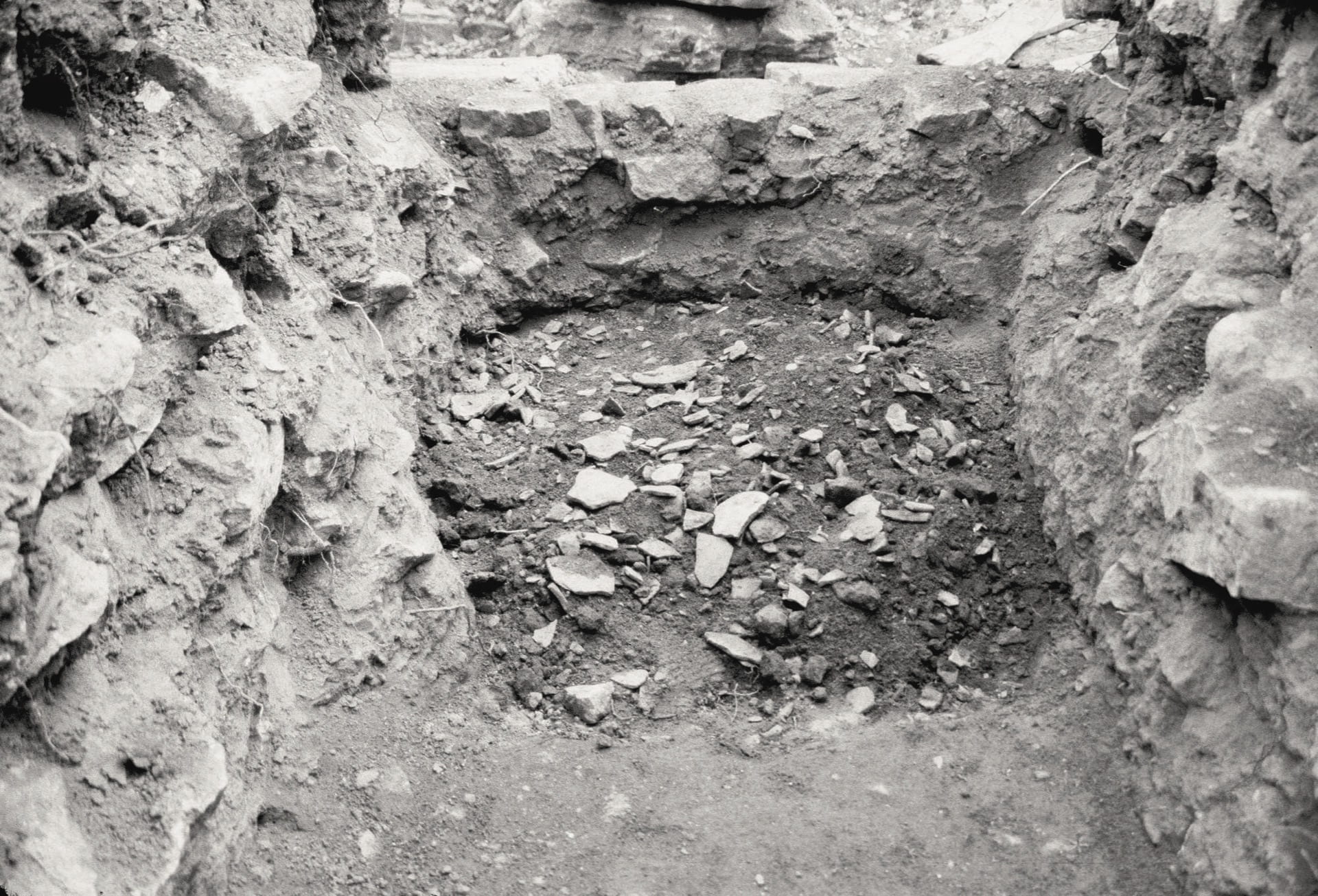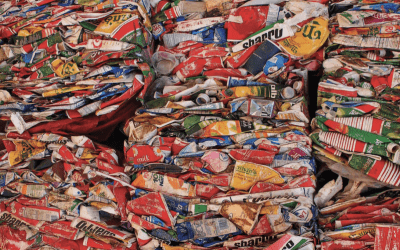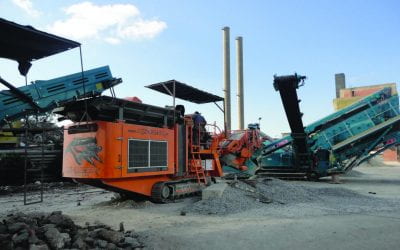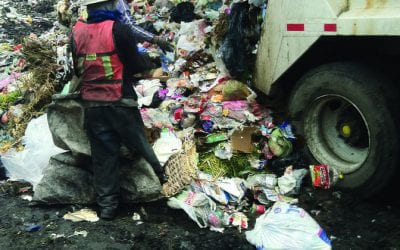Trash as Treasure
Learning from an Ash Heap of History in Copan, Honduras

A Late Classic Royal Residence beside the Acropolis at Copan, Honduras. Photo courtesy of William L. Fash.
The adage “One person’s trash is another person’s treasure” rings true for all of us who have happily devoted our professional lives to the study of archaeology. We make our livelihoods—and more importantly we build, dismantle and re-build cultural histories and archaeological theory—through the concerted study of material culture. The Merriam Webster Dictionary defines material culture as the totality of physical objects made by a people for the satisfaction of their needs, especially those articles requisite for their sustenance.
Much archaeological research consists of the careful recovery of broken things that got discarded because they were no longer useful to their makers. In practical terms, this means that we study discards and yes, wherever and whenever possible, mounds of trash! Most field (or “dirt”) archaeologists find a nice thick midden (trash) deposit at least as informative as the whole objects that were left as special offerings to revered ancestors and supernatural forces (or “gods,” in Western practice and parlance).
The Classic Maya ruins in Copan, Honduras, where we have conducted much archaeological research, provide an excellent example. There, Will (the co-author of this article) uncovered and recovered a large ash-layer midden in the royal residential complex that proved enormously informative. During our time together as director and co-director of the Copan Acropolis Archaeological Project (1988-1996), Will devoted several seasons of field research to the investigation of architectural Group 10L-2, on the south flank of the Acropolis. Evidence indicates that this residential compound had a series of discrete architectural components that were used for different purposes by the ruler, his immediate family and courtiers. These included a large public plaza area, a royal receiving area, residences for the ruler himself, his offspring, and several courtiers, a royal ancestor shrine, and a kitchen area that had been re-purposed from an earlier use as a royal burial ground. Underlying the central part of the residential compound was the midden, which proved vital for understanding not only Will’s site, but the political and economic history of the entire kingdom, a true archaeological “treasure.”

The Gray Ashy Trash Layer in Group 10L-2, the Late Royal Residence at Copan. Photo courtesy of William L. Fash.
Hieroglyphic inscriptions were found in association with four of the buildings on the public plaza or “Patio A” of this royal residential area. The project epigraphers Linda Schele and David Stuart deciphered the texts, which discuss the different rituals performed there by the 16th and final ruler in Copan’s history, Yax Pasaj Chan Yopat, who reigned from 763-822 C.E. These were very useful for identifying the uses of the group and its constituent buildings during their final decades of use, the names of the patron gods of the dynasty associated with the royal ancestor shrine, the identification of the supernatural patron of the final ruler himself (Cha’ak, the Rain god), and the importance he attached to rituals performed by the founder of the dynasty, at Teotihuacán, Mexico. But they did little to provide time-depth for either the life history of this vitally important architectural complex, or for the entire run of the Late Classic period (600-850 C.E. in Copan), when the Copan kingdom reached its maximum size and importance in the larger arena of ancient Maya history.
All of that changed when Will and his graduate students came across an ash layer underlying the great Late Classic edifices that they had so painstakingly uncovered, studied, and restored (Andrews and Bill 2005). This unprecedented layer, chock full of royal “discards,” constituted—quite literally—an ash heap of history that provided the single best “treasure trove” of ancient pottery ever unearthed in Copan or any other ancient Maya kingdom. The ash layer ran some 10 m. (31 feet) N-S by 20 m. (61 feet) at its widest extent, in places up to nearly a meter in depth. No one has ever found better preserved examples of the entire gamut of ceramic types, forms, and decorative techniques than those encountered in this enormous feature. In most places, truth to tell, there were more potsherds in the ash layer than ash and earth.
When all the evidence was in, it became apparent that the deposit represented the remains of an enormous stratum of trash—a layer of fill prior to putting up a series of buildings—containing the discards from quotidian activities on the Acropolis of Copan. Besides the incredible number, variety, preservation and fine artisanship that went into this group of ceramics, the consistency of the material proved that it represented a very short window of time in the occupation and use of the Acropolis. This meant that it could be used to define a “baseline” for all of the different attributes of Late Classic Copan pottery at the time of the use and discard of the material. This included the sizes, shapes (or “forms”), vessel diameters, constituent materials (clay “paste” and “clastic temper”) of the different types of pots, decorative techniques, and evidence for use-ware within and between types, for the window of time (650-700 C.E.) when the material was used and discarded.
So what? Well, the “what” is that all archaeologists (and many archaeological theories) live and die by their potsherds! They are non-biodegradable, and are found anywhere people settled down in agriculturally based societies, be it at the village, town, or city level of societal integration. Pottery can tell us more about ancient economics (including subsistence, foodstuff preparation, trade with neighboring societies, ritual practices and daily life) than virtually any other class of material culture. Furthermore, pottery is associated with buildings used for different purposes, giving us a window onto the specialized activities of religious practitioners, craftspeople, and the lifestyles of everyone from the humblest farmers to the kings in their royal palaces. One thing the ash layer made abundantly clear was that the royal family had access to better-made pottery, and to much more of the most beautiful, polychrome Late Classic “serving ware” vessels imported from the best pottery workshops in the Maya lowlands to the north and west, than anyone else in the kingdom.
Needless to say, the ash layer and particularly its ceramic contents proved to be an incredibly useful archaeological resource for Cassandra Bill, who based much of her doctoral dissertation at Tulane on the production of ceramics in Copan on this material. Its ancillary research uses included enabling Bill to provide a much more refined chronological breakdown of the diagnostic attributes of Late Classic Copan pottery (Bill 1997). Thanks to the midden, instead of only being able to say that a particular lot of potsherds (the broken pieces of pots)—and the building or feature with which it was directly associated—“dates to the Late Classic period,” a span of 250 years in Copan, now all the archaeologists working in the region can say that a particular lot of sherds dates either to the first half of the 7th century (with attributes that antedate the kinds of pottery found in the 10L-2 ash heap); or from 650-700 (the time of use and deposition of the 10L-2 ash heap); or from 700-750 (based on the other middens associated with the buildings immediately post-dating the ash layer); or to the final years of the dynasty (750-820), ending with the burning of the ancestor shrine of Group 10L-2. A small sample of “Terminal Classic” pottery, associated with the brief post-dynastic occupation of the site from 820-850, rounds out the picture, and the ceramic sequence.
Given that most of the 3,400+ buildings that are visible on the present land surface date to the Late Classic period, this new level of chronological control was an enormous step forward (Andrews and Fash 2005). Now we are able to document and interpret the social history of the vast numbers of people who comprised the supporting population of the valley at these three keys points in the city’s history: during its rise to greatest power (600-700); during its artistic apogee and a brief political crisis (700-750); and during the final glory years when its last two rulers struggled to maintain unity in the region in the face of immense environmental, social, and political challenges (750-820). The end of the city’s history was violent, with the burning of temples and even the burning and ransacking of the final ruler’s tomb, constructed immediately adjacent to Group 10L-2. Thus, a single ash heap will help all future archaeologists working in Copan to understand “people’s history” on a much more secure footing. This humble layer of trash will ultimately also benefit other scholars and laypersons interested in the study of the rise and fall of that great urban tradition, by placing the experiences of other Maya cities in a broader comparative perspective.
Winter 2015, Volume XIV, Number 2
William L. Fash is the Bowditch Professor of Central American and Mexican Archaeology and Ethnology, Department of Anthropology, Harvard University, and a member of the DRCLAS Executive Committee.
E. Wyllys Andrews is Professor Emeritus of Anthropology and Director Emeritus, Middle American Research Institute, Tulane University.
Related Articles
Garbage: Editor’s Letter
Religion is a topic that’s been on my ReVista theme list for a very long time. It’s constantly made its way into other issues from Fiestas to Memory and Democracy to Natural Disasters. Religion permeates Latin America…
Buenos Aires, Wasteland
English + Español
Walking down Avenida Juan de Garay last week, I passed a giant black trash bag that had ballooned and burst. Orange peels, tomatoes, candy wrappers…
First Take: Waste
Waste—its generation, collection and disposal—is a major global challenge in the 21st century. Cities are responsible for managing municipal waste. Solid…





